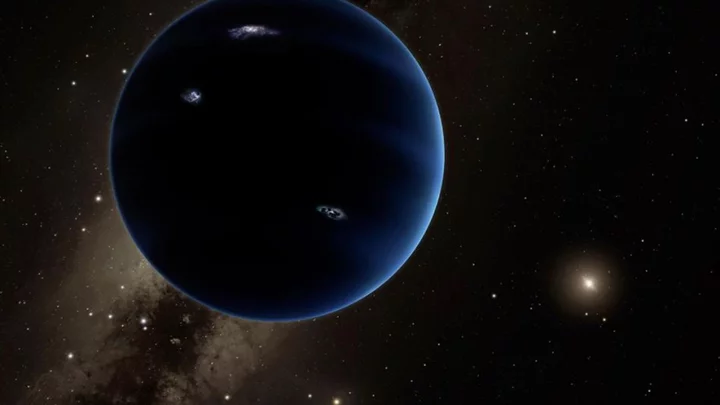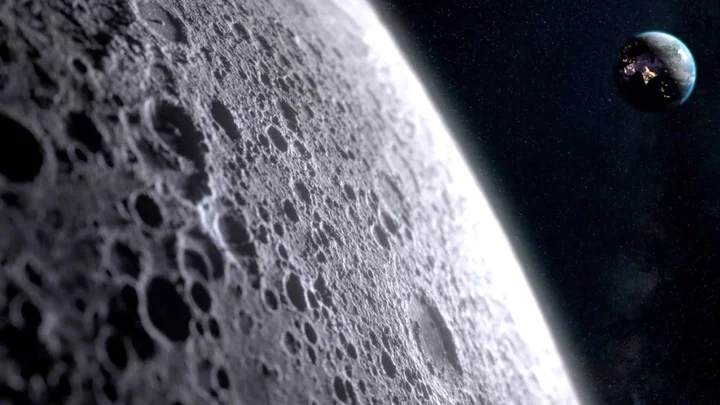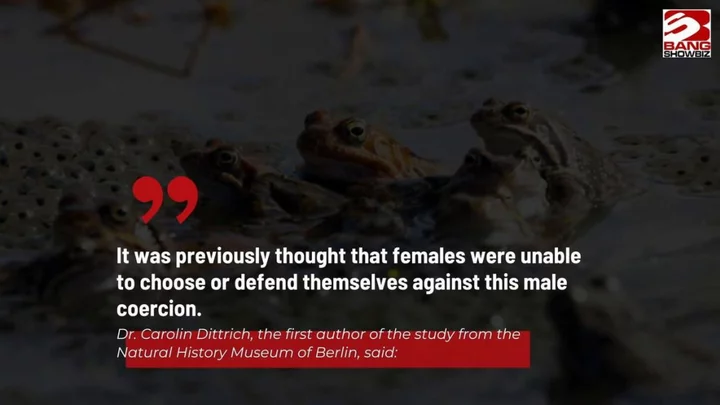
Conspiracy theorists believe there is a secret planet
Conspiracy theorists think that there is a hidden planet in out Solar System that will eventually destroy humanity. That's right, conspiracy theorists believe there is a secret ninth planet that was discovered by 19th-century astronomer Percival Lowell. The planet was given the name 'Planet X', also known as Nibiru, by Lowell, who believed the inhabitants of the planet made humans who we are today. Despite Lowell never actually seeing the mystery planet, he was convinced of its existence and left $1 million to fund research about the planet after he passed away in 1916. A hundred years later and all the money spent, it was concluded that the planet never existed. But this hasn't stopped conspiracy theorists from vowing to continue the search. With Caltech professors Mike Brown and Konstantin Batygin even going as far as to co-author a paper suggesting the planet exists "I didn't have a particularly strong appreciation for just how difficult would be to find Planet Nine until I started looking together with Mike using telescopes," Professor Batygin told the BBC. "The reason it's such a tough search is because most astronomical surveys are not looking for a single thing." It was initially predicted that Planet X would bring about the end of the world in 2003, but it did not smash into Earth as had been suggested. In 2012 it was again predicted that the planet would collide with Earth at the end of the year, which I don't need to tell you, did not happen. Dr Scott Sheppard and Professor Chad Trujillo sought to explain a strange cluster of six small objects in the Kuiper Belt beyond Neptune back in 2014. They suggested that a large planet was lurking in the solar system, with Dr Sheppard saying: "These distant objects are like breadcrumbs leading us to Planet X. 'The more of them we can find, the better we can understand the outer Solar System and the possible plant that we think is shaping their orbits - a discovery that would redefine our knowledge of the Solar System's evolution." Sign up to our free Indy100 weekly newsletter Have your say in our news democracy. Click the upvote icon at the top of the page to help raise this article through the indy100 rankings.
2023-10-16 18:19

Older people could see a surprising health benefit from having an active sex life
A US study has revealed that sexual activity in older people is linked to better cognitive function later. The study by sociologists Shannon Shena from Hope College and Hui Liub from Purdue University, published in The Journal of Sex Research looked at attention, memory, language, conceptual thinking, calculations, and orientation and found that sex is linked to better brain health across all age groups. Those aged 75 to 90 were found to have significantly better cognitive function five years on if they were currently having sex at least once a week. For adults aged 62 to 74, on the other hand, the most important factor for future brain health was the quality of sex being had, in terms of both physical and emotional aspects. "As seen in our sample, promoting sexual quality among younger-old couples may be a way to combat the interruptions which people anticipate to come with aging," Shena and Luib said "and these feelings of sexual quality may manifest in their later cognitive health." Shena and Liub think there are several reasons why these results could be the case. Sex involves physical exercise, which means improved cognitive performance may be due to improved cardiovascular health, which, in turn, can increase blood flow to the brain and reduce inflammation. Sex can also reduce stress, and stress is thought to prevent the neuronal growth in some parts of the brain associated with memory. Finally, sex may improve cognitive function through the release of dopamine, which is a neurotransmitter linked to improved memory. "Our findings help to contextualize a multifaceted understanding of healthy aging and speak to clinical practices and policy decisions regarding cognitive health," Shena and Luib wrote, "and in particular how it may be related to sexual life, an often overlooked area for older adults." Sign up to our free Indy100 weekly newsletter Have your say in our news democracy. Click the upvote icon at the top of the page to help raise this article through the indy100 rankings.
2023-10-14 20:23

A hidden underground ocean could be causing ‘slow-motion' earthquakes
Scientists think they could have found the cause of a series of “slow-motion” earthquakes that have shaken New Zealand in recent years – a hidden ocean which sits two miles beneath the sea floor. The water was revealed as part of a giant volcanic area formed about 125 million years ago, when an eruption forced a plume of lava bigger than the US to the surface of the Earth. Researchers found the region by towing 3D seismic sensors behind a boat to build up an image of the ancient volcanic area. There, they found thick, layered sediments around long-buried volcanoes which contained much more water than expected. Andrew Gase, from the University of Texas Institute for Geophysics, who carried out the research, said: “Normal ocean crust, once it gets to be about seven or 10 million years old should contain much less water.” The ocean crust scanned by researchers was 10 times as old as this – but water made up nearly half its volume. The tectonic fault line which runs through New Zealand is known for producing slow-motion earthquakes, also known as slow slip events. During one of these, the energy from an earthquake gets released over days or months, often causing little or no harm to people. Scientists don’t know why they happen more at some faults than at others, but they are thought to be linked to buried water. Finding this new area of water at the fault line which creates so many slip events could provide an explanation. Gase said: “We can't yet see deep enough to know exactly the effect on the fault, but we can see that the amount of water that's going down here is actually much higher than normal.” If researchers can work out how the water reserves affect slip events – possibly by dampening them – they could, in turn, understand normal earthquakes better. Scientists also think underground water pressure could play a key part in creating conditions that release tectonic stress via slow slip earthquakes. As a result, Gase said scientists should drill even deeper to find out where the water ends up. Sign up to our free Indy100 weekly newsletter Have your say in our news democracy. Click the upvote icon at the top of the page to help raise this article through the indy100 rankings.
2023-10-13 22:50

Instagram has made an AI Kendall Jenner and it's scarily realistic
An AI version of Kendall Jenner is going viral after it was launched by Meta as part of Instagram introducing the future of technology on the app. Known as 'Billie' (@yoursisbillie), it's thought the Keeping Up With The Kardashians star was paid 'millions' to lend her face and voice to the account, which offers advice to fans - and it's near-impossible to tell it's not real. "I don't like this, I don't like where the world is heading, I'm not gonna support this," one terrified user wrote in the comments. Sign up to our free Indy100 weekly newsletter
2023-10-13 21:50

Low-flying helicopter sparks crazy crocodile orgy in Australia
Hundreds of crocodiles in Australia were recently sent into a sex frenzy when a low-flying Chinook helicopter passed overhead. Ranchers from the Koorana Crocodile Farm in Queensland, which houses more than 3,000 crocodiles, said many of their residents became aroused after the flyby. John Lever, owner of the farm, said pilots use it as a marker point in their flights. When a pilot flew low so their passengers could take a picture of the crocodiles, the reptiles were whipped up into a frenzy. He said: “All of the big males got up and roared and bellowed up at the sky, and then after the helicopters left they mated like mad. “There's something about the sonic waves that really gets them stirred up.” As it turns out, thunderstorms regularly act as an aphrodisiac to crocodiles. If the reptiles mate during storm season, their babies are more likely to hatch in a non-thunderstorm season, meaning they don’t drown in flood water. “The crocodiles start vocalising to each other [when a storm is coming],” Lever said. “They don't have a very sophisticated voice box, but they vibrate their windpipes to send messages through the water.” That may explain why the helicopter caused such an aroused response – they thought it was a megastorm. Herpetologist Mark O'Shea from the University of Wolverhampton told LiveScience: “Chinooks may artificially recreate the sound of the start of a thunderstorm.” Another possible explanation is that the movements in the water or downward wind caused by the choppers could trick them into thinking there is a change of atmospheric pressure, like when a storm is approaching. “I imagine that the downdraft from a large, heavy helicopter would create a change in pressure that the [sensory organs] on crocodile skin can detect. “Dropping barometric pressure from a downdraft may resemble the change in pressure from a storm.” Sign up to our free Indy100 weekly newsletter Have your say in our news democracy. Click the upvote icon at the top of the page to help raise this article through the indy100 rankings.
2023-10-13 20:51

Scientists could use lunar dust to make roads on the moon
Scientists have come up with a potential solution to deal with dust on the moon which makes conducting research tricky. Dust erodes space suits, clogs machinery, interferes with scientific instruments and makes moving around on the surface difficult. But they reckon moon dust could be melted using a giant lens developed by the European Space Agency to create solid roads and landing areas. Using a fine-grained material called EAC-1A, developed as a substitute for lunar soil, scientists used a 50mm diameter laser beam to heat the dust to about 1,600C and melt it. Then they traced out bendy triangle shapes, which could be interlocked to create solid surfaces across large areas of lunar soil to be used as road. However it would take about 100 days to create a 10 x 10m landing spot so it is not a quick fix. To make matters worse, the lens needed for the laser to work would be difficult to transport from Earth and could also get dust in it which may reduce its functionality. “You might think: ‘Streets on the moon, who needs that?’” said Prof Jens Günster, of the Federal Institute of Materials Research and Testing in Berlin and co-author of a report on the possible solution. “But in fact it’s a kind of depressing demand [even] early on. It’s very loose material, there’s no atmosphere, gravity is weak, so the dust gets everywhere. It contaminates not only your equipment but other nations’. No one would be happy to be covered in dust from another rocket." Dust has blighted previous missions, such as the Surveyor 3 spacecraft (damaged by dust kicked up by the Apollo 12 landing), and overcoming this challenge is a priority for Nasa, which aims to establish a permanent lunar outpost. Transporting building materials to the moon would be too expensive, so there is a need for unconventional solutions. “You need to use what’s there and that’s simply loose dust,” said Günster. The findings are published in the journal Scientific Reports. Sign up to our free Indy100 weekly newsletter Have your say in our news democracy. Click the upvote icon at the top of the page to help raise this article through the indy100 rankings.
2023-10-13 20:19

EU opens an investigation into Elon Musk's X over 'disinformation'
The EU has opened an investigation into Elon Musk's X over the possible spread of terrorist and violent content, and hate speech, after Hamas' attack on Israel. The EU's industry chief, Thierry Breton, confirmed on Thursday the bloc had sent Twitter/X a "formal request for information" to determine whether the platform was complying with the Digital Services Act (DSA) - a law designed to protect users of big tech platforms which came into effect November, as misinformation about the conflict between Israel and Hamas spreads on social media. In a statement on Thursday, the EU said “the European Commission services sent to X a formal request for information under the Digital Services Act (DSA)”. “This request follows indications received by the Commission services of the alleged spreading of illegal content and disinformation, in particular the spreading of terrorist and violent content and hate speech. The request addresses compliance with other provisions of the DSA as well.” In his letter to Musk, Breton said "violent and terrorist content" had not been taken down from X, despite warnings. Breton did not give details on the disinformation he was referring to in the letter, but said instances of "fake and manipulated images and facts" were widely reported on the social media platform. Responding on X, Musk said: "Our policy is that everything is open and transparent, an approach that I know the EU supports. "Please list the violations you allude to on X, so that the public can see them." X chief executive Linda Yaccarino also said earlier on Thursday the platform had removed hundreds of Hamas-affiliated accounts and taken action to remove or label tens of thousands of pieces of content since Saturday's attack. Sign up to our free Indy100 weekly newsletter Have your say in our news democracy. Click the upvote icon at the top of the page to help raise this article through the indy100 rankings.
2023-10-13 18:16

Nasa is looking for diamonds and precious stones on metal asteroid
Nasa is sending a rocket to a metallic asteroid between Mars and Jupiter in the hope of finding diamonds and rubies. The mission, which is set to launch on Friday 13 October, will involve visiting the mysterious metallic asteroid 16 Psyche, which sits in an asteroid belt between the two planets. The journey will take seven years for Falcon Heavy, a craft made by Elon Musk’s space exploration firm SpaceX. It was due to take off on Thursday, but the launch was postponed because of bad weather. Nasa Administrator Bill Nelson said: “We are launching a billion dollar spacecraft all the way beyond Mars and close to Jupiter and it’s going to snuggle up next to a metallic asteroid, and we are going to learn something about that metallic asteroid. “I hope we might find diamonds and rubies on that asteroid. “Everything is a new discovery, and we are glimpsing more of the development of this magnificent thing we call the universe.” Falcon Heavy takes off on its four-billion-mile journey at 10.19am in Florida, from the Kennedy Space Center. That is 3.16pm UK time. By May 2026, it will pass by Mars and use the planet’s gravitational force to slingshot itself toward the asteroid. Four years later, it will reach its destination. There, it will find a rock made up of iron and nickel, scientists believe. But they also think it could contain precious metals and gems. 16 Psyche has puzzled astronomers since it was discovered by Italian astronomer Annibale de Gasparis in 1852. In the 1980s, radar readings found that it was made of metal, leading scientists to speculate that the 130-mile boulder lost its outer shell by colliding with other asteroids. The spacecraft will spend about 26 months in orbit, taking images of the asteroid to get a clearer picture of its topography, surface features, gravity and magnetism. The asteroid will not be mined – but space agencies might just start taking more notice if they find its one massive diamond. Sign up to our free Indy100 weekly newsletter Have your say in our news democracy. Click the upvote icon at the top of the page to help raise this article through the indy100 rankings.
2023-10-13 18:15

A scientist may have just proven that we all live inside a computer simulation
“The Matrix is everywhere. It is all around us. Even now in this very room." So says Laurence Fishburne’s Morpheus in sci-fi classic ‘The Matrix’ as he offers Keanu Reeves’s Neo the choice to find out just how “deep the rabbit hole goes”. Now, just as Neo discovered that the "life" he'd been living was little more than an algorithmic construct, scientists and philosophers are arguing that we could be stuck inside a simulation ourselves. In a paper published earlier this month, physicist Melvin Vopson, of the University of Portsmouth, offered scientific evidence for a philosophical theory known as the simulation hypothesis. This, in a nutshell, posits that the entire universe and our objective reality are just super-advanced virtual reality illusions. Elon Musk is among the well-known fans of the theory, which – as Dr Vopson notes in his paper – has been “gaining traction in scientific circles as well as in the entertainment industry”. The university lecturer also pointed out that recent developments in a branch of science known as information physics “appear to support this possibility”. Information physics suggests that physical reality is made up of bits of information. However, Dr Vopson has gone further and is working to prove that information has a physical mass and is a fundamental building block of the universe. He even claims that information could be the mysterious dark matter that makes up almost a third of the universe. In previous research, the physicist proposed that all elementary particles (the smallest known building blocks in the universe), store information about themselves, much like DNA in humans. Then, in 2022, he discovered a new law of physics, christened the second law of infodynamics, which states that entropy – the degree of randomness or disorder – within an isolated information system either remains constant or decreases over time. In other words, the system becomes less and less chaotic, implying that there is some kind of mechanism governing it rather than random chance. “I knew then that this revelation had far-reaching implications across various scientific disciplines,” Dr Vopson said in a statement released by the University of Portsmouth. “What I wanted to do next is put the law to the test and see if it could further support the simulation hypothesis by moving it on from the philosophical realm to mainstream science.” Is the Universe a Simulation? | Melvin Vopson www.youtube.com Dr Vopson employed the law in a range of different fields, including genetics, cosmology and even symmetry. Here, he found that the abundance of symmetry in the Universe (think snowflakes and facial structures) could be explained by the second law of infodynamics. "Symmetry principles play an important role with respect to the laws of nature, but until now there has been little explanation as to why that could be,” he said. “My findings demonstrate that high symmetry corresponds to the lowest information entropy state, potentially explaining nature's inclination towards it." Again, put simply, nature prefers things to be as well-ordered as possible. He continued: “This approach, where excess information is removed, resembles the process of a computer deleting or compressing waste code to save storage space and optimise power consumption.” As a result, this “supports the idea that we’re living in a simulation.” Dr Vopson is serious about this idea and, last year, even launched a crowdfunding campaign to test it. At the time, he announced that he had designed an experiment to determine whether we are all just characters in an advanced virtual world. “There is a growing community out there looking seriously at the possibility that information is more fundamental to everything than we think,” he said in a statement released back in December. “If information is a key component of everything in the universe, it would make sense that a vast computer somewhere is in control. “Assuming the universe is indeed a simulation, then it must contain a lot of information bits hidden everywhere around us. I’ve devised an experiment that proposes a way of extracting this information to prove it’s there.” His proposed experiment is based on his conclusion that information is physical and that elementary particles have a DNA of information about themselves. He posited that the information in an elementary particle could be detected and measured by using particle-antiparticle collision. “We can measure the information content of a particle by erasing it. If we delete the information from the particles, we can then look at what’s left,” he said in the December statement. “This experiment is highly achievable with our existing tools, and I’m hoping the crowdfunding site will help us achieve it.” And whilst the crowdfunder closed well before reaching its proposed £185,000 target, Dr Vopson still hopes to carry out the ambitious test. Following his most recent paper, he suggested the experiment had the power to confirm the “fifth state of matter in the universe” and “change physics as we know it.” Sign up for our free Indy100 weekly newsletter Have your say in our news democracy. Click the upvote icon at the top of the page to help raise this article through the indy100 rankings.
2023-10-13 16:17

Female frogs fake their own deaths to avoid sex with overzealous males
Some female frogs will go to the extent of faking their own deaths to avoid sex with their male counterparts, a new study has revealed. Researchers in Berlin and Finland focused on the European common frog for their investigation owing to the often alarming nature of the species' mating process. The short breeding season means that several males often cling to a single female – in a pile-on that can cause the female to drown. (So, pretty understandable that they might want to avoid this.) For the research published in the Royal Society Open Science, European common frogs were collected and divided into tanks where there were two females and one male in each. Before this research, it was thought that the females couldn't defend themselves against the aggressive amorous act. However, a number of the wily participants displayed the three avoidance behaviours. A rotation technique to escape mating was a popular option – carried out by 83 per cent of the females. While nearly half of them (48 per cent) mimicked how male frogs sound to trick them into letting them go. In 33 per cent of the females, the researchers recorded a stiffening of arms and legs for two minutes, in a convincing bid to play dead. Out of the females who got mounted by a lustful male, almost half were able to escape thanks to at least one of these avoidance behaviours. “The smaller females also showed the full repertoire of behaviours more often than the larger females," the researchers noted, and younger females were more likely to pretend they were dead. However, question marks remain on whether the frogs fake their death as a conscious choice or whether it is a stress response or even a means to test the male’s strength and endurance. “I think even if we call this species a common frog and think we know it well, there are still aspects we don’t know and perhaps haven’t thought about," Dittrich explained to The Guardian. Sign up to our free Indy100 weekly newsletter Have your say in our news democracy. Click the upvote icon at the top of the page to help raise this article through the indy100 rankings.
2023-10-12 21:15

NASA discover signs of water and carbon on asteroid sample
NASA has lifted the lid on its first findings about the Bennu sample, one of the "most hazardous known asteroids". The highly-anticipated sample from the OSIRIS-REx’s mission took seven years to complete and finally made a safe landing on Sunday 24 September. Scientists audibly gasped upon opening the capsule. They kept details to a minimum and maintained a slow pace in progress for "good reason," as they received more material than expected. "The abundance of material found when the science canister lid was removed earlier this week has meant that the process of disassembling the TAGSAM (Touch-and-Go Sample Acquisition Mechanism) head – which holds the bulk of material from the asteroid – is off to a methodical start," they said a the time. That was until now... On Wednesday 11 October, the space agency shared details for the first time from NASA experts and the University of Arizona. NASA said there were signs of water and carbon on the sample through hydrated clay minerals that contain carbon. "At nearly 5% carbon by weight, carbon being the central element of life, far exceeding our goal of 60g, this is the biggest carbon-rich asteroid sample ever returned to earth," Administrator Bill Nelson said, adding that it was "exactly the kind of material that we wanted to find." He went on to suggest that "they are going to help us determine the origin of elements that could have led to life" and provide a greater understanding of how to protect Earth from asteroids. Scientists also revealed that the sample contained space dust from 4.5-billion-year-old asteroid Bennu. NASA showed the audience the sample on a video to protect the sample and to prevent contamination. Speaking about working through a glove box to analyse the sample, Francis McCubbin, astronomical curator at NASA's Johnson Space Centre said: "[It is] "hard, challenging work, and it does not go quickly, but we need to do this right". The samples will be preserved so that "scientists that aren't even born yet are going to have the opportunity to answer questions about our universe with these samples using technology that has not even been invented." Sign up for our free Indy100 weekly newsletter Have your say in our news democracy. Click the upvote icon at the top of the page to help raise this article through the indy100 rankings.
2023-10-12 16:21

NASA releases first photos and findings from Bennu asteroid sample
NASA has lifted the lid on its first findings about the Bennu sample, one of the "most hazardous known asteroids". The highly-anticipated sample from the OSIRIS-REx’s mission took seven years to complete and finally made a safe landing on Sunday 24 September. Scientists audibly gasped upon opening the capsule. They kept details to a minimum and maintained a slow pace in progress for "good reason," as they received more material than expected. "The abundance of material found when the science canister lid was removed earlier this week has meant that the process of disassembling the TAGSAM (Touch-and-Go Sample Acquisition Mechanism) head – which holds the bulk of material from the asteroid – is off to a methodical start," they said a the time. That was until now... On Wednesday 11 October, the space agency shared details for the first time from NASA experts and the University of Arizona. NASA said there were signs of water and carbon on the sample through hydrated clay minerals that contain carbon. "At nearly 5% carbon by weight, carbon being the central element of life, far exceeding our goal of 60g, this is the biggest carbon-rich asteroid sample ever returned to earth," Administrator Bill Nelson said, adding that it was "exactly the kind of material that we wanted to find." He went on to suggest that "they are going to help us determine the origin of elements that could have led to life" and provide a greater understanding of how to protect Earth from asteroids. Scientists also revealed that the sample contained space dust from asteroid Bennu. NASA showed the audience the sample on a video to protect the sample and to prevent contamination. Speaking about working through a glove box to analyse the sample, Francis McCubbin, astronomical curator at NASA's Johnson Space Centre said: "[It is] "hard, challenging work, and it does not go quickly, but we need to do this right". The samples will be preserved so that "scientists that aren't even born yet are going to have the opportunity to answer questions about our universe with these samples using technology that has not even been invented." Sign up for our free Indy100 weekly newsletter Have your say in our news democracy. Click the upvote icon at the top of the page to help raise this article through the indy100 rankings.
2023-10-12 00:21
